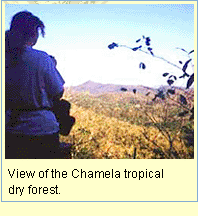
| Brazilian River Otters | |
| Costa Rican Caterpillars | |
 |
||
|
Wildlife biologist Dr. Carlos López González and Earthwatch
teams have been tracking wild cats and other carnivores
at Chamela for over ten years. Their objective is to estimate numbers
of carnivore species in the area. Carlos and his research colleague,
Dr. Alberto Gonzalez Romero, are focusing on wild cats and small carnivores
because of the important role these animals play in conserving the tropical
dry forest.
Unlike a rainforest
which is lush and green all year round, the tropical dry forest at Chamela
has two seasons: rainy and dry. During the rainy season (June through
October) the forest resembles a rain forest and is very green. During
the dry season (November through May), the trees lose their leaves and
is much more brown. Chamela receives less than 30 inches of rain during
the whole year. Compare that amount with the year-round rain fall in a
rain forest. La Selva in Costa Rica, the caterpillar research site, receives
about 12 feet of rain each year.
As you look out to the west over the hilly, forested terrain, you
can see all the way to the Pacific Ocean. The water is just beyond the
furthest ridge of mountains, only about three to four miles away. Altogether
the reserve covers about 13,000 hectares (52 square miles).
Chamela is rich in wildlife, but the future is uncertain. The development
of tourist resorts along the coast, the clearing of land for farming,
and hunting threaten not only threaten the survival of wild cats, but
the whole ecosystem.
Photo courtesy of Jen Vogel/Earthwatch Institute |
||
 Hola
from Mexico! Welcome to the Chamela-Cuixmala Biosphere Reserve and the
tropical dry forest.
Hola
from Mexico! Welcome to the Chamela-Cuixmala Biosphere Reserve and the
tropical dry forest.